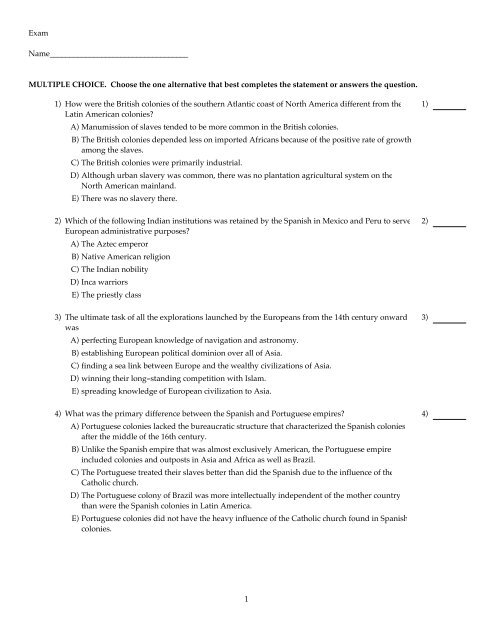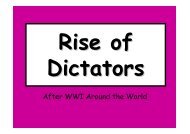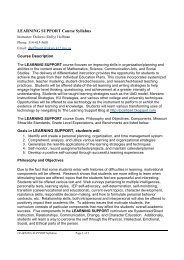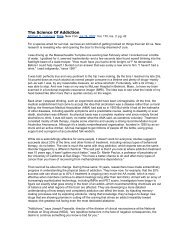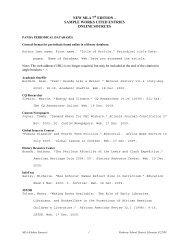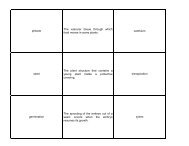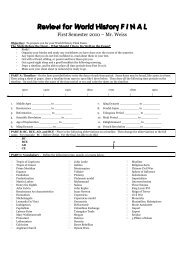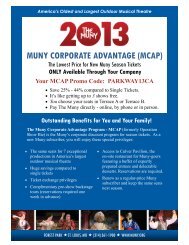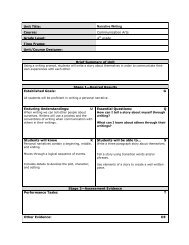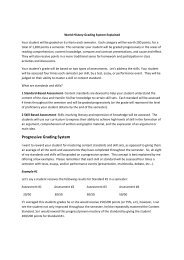Unit 4 Test_19_22
Unit 4 Test_19_22
Unit 4 Test_19_22
Create successful ePaper yourself
Turn your PDF publications into a flip-book with our unique Google optimized e-Paper software.
Exam<br />
Name___________________________________<br />
MULTIPLE CHOICE. Choose the one alternative that best completes the statement or answers the question.<br />
1) How were the British colonies of the southern Atlantic coast of North America different from the<br />
Latin American colonies?<br />
A) Manumission of slaves tended to be more common in the British colonies.<br />
B) The British colonies depended less on imported Africans because of the positive rate of growth<br />
among the slaves.<br />
C) The British colonies were primarily industrial.<br />
D) Although urban slavery was common, there was no plantation agricultural system on the<br />
North American mainland.<br />
E) There was no slavery there.<br />
2) Which of the following Indian institutions was retained by the Spanish in Mexico and Peru to serve<br />
European administrative purposes?<br />
A) The Aztec emperor<br />
B) Native American religion<br />
C) The Indian nobility<br />
D) Inca warriors<br />
E) The priestly class<br />
3) The ultimate task of all the explorations launched by the Europeans from the 14th century onward<br />
was<br />
A) perfecting European knowledge of navigation and astronomy.<br />
B) establishing European political dominion over all of Asia.<br />
C) finding a sea link between Europe and the wealthy civilizations of Asia.<br />
D) winning their long-standing competition with Islam.<br />
E) spreading knowledge of European civilization to Asia.<br />
4) What was the primary difference between the Spanish and Portuguese empires?<br />
A) Portuguese colonies lacked the bureaucratic structure that characterized the Spanish colonies<br />
after the middle of the 16th century.<br />
B) Unlike the Spanish empire that was almost exclusively American, the Portuguese empire<br />
included colonies and outposts in Asia and Africa as well as Brazil.<br />
C) The Portuguese treated their slaves better than did the Spanish due to the influence of the<br />
Catholic church.<br />
D) The Portuguese colony of Brazil was more intellectually independent of the mother country<br />
than were the Spanish colonies in Latin America.<br />
E) Portuguese colonies did not have the heavy influence of the Catholic church found in Spanish<br />
colonies.<br />
1)<br />
2)<br />
3)<br />
4)<br />
1
5) How successful was the Portuguese monopoly on Asian products?<br />
A) The Portuguese monopoly was rigidly enforced over Asian products for almost two centuries.<br />
B) Though they managed to monopolize some spices grown in limited locales, the Portuguese<br />
lacked the manpower and ships to sustain a monopoly.<br />
C) The Portuguese were unable to achieve control over any Asian products due to competition<br />
from the Chinese commercial navy.<br />
D) For some decades they were able to maintain a complete monopoly over Asian products<br />
shipped to Europe.<br />
E) Other European trade powers were frozen out of the market due to the success of the<br />
Portuguese establishing fortified trade ports.<br />
6) What was the African contribution to the "Colombian Exchange"?<br />
A) Potatoes<br />
B) Tapioca<br />
C) Manioc<br />
D) Slaves<br />
E) Large mammals<br />
7) In terms of literature, what was the chief accomplishment of the Ming era?<br />
A) Poetry<br />
B) The novel<br />
C) Haiku<br />
D) Narrative history<br />
E) The short story<br />
8) How did the profitability of the slave trade compare to that of other contemporary business<br />
ventures?<br />
A) The slave trade was less profitable in the Sahara trade but extremely profitable for the Atlantic<br />
slave traders.<br />
B) Profits from the slave trade in the 18th century were so lucrative that capital derived from the<br />
trade in human beings was used to capitalize the European Industrial Revolution.<br />
C) The slave trade was less profitable on the whole than other business ventures because of the<br />
high costs and risks involved.<br />
D) The slave trade became increasingly dangerous and risky, so that by the 18th century its<br />
returns were minimal and most participants were bankrupted.<br />
E) The slave trade was little more profitable than most business activities of the age and was not a<br />
major source for the Industrial Revolution of Europe.<br />
5)<br />
6)<br />
7)<br />
8)<br />
2
9) Why did the Chinese abandon the commercial voyages of the Zhenghe expeditions?<br />
A) Many of the ships were lost as a result of poor ship design and inadequate sailing technology.<br />
B) There was little of value for the Chinese to import in trade, and the voyages were expensive to<br />
carry out.<br />
C) Chinese commerce was not competitive enough due to competition from the Europeans.<br />
D) The size of the fleets was so limited that they could not compete with the greater capacity of<br />
the European voyages.<br />
E) The trade with foreign regions produced a negative balance of trade for China that drained<br />
bullion from imperial coffers.<br />
10) How did the Dutch commercial strategy within the Asian trade network differ from that of the<br />
Portuguese?<br />
A) The Dutch lacked a substantial navy, and could not use warships to maintain their commercial<br />
advantage.<br />
B) The Dutch were more humane in their treatment of island peoples who cultivated the spices.<br />
C) The Dutch were more systematic in their monopoly control of a limited number of specific<br />
spices.<br />
D) The Dutch did not make use of fortified towns and factories.<br />
E) The Dutch were more interested in establishing permanent settlements such as Batavia.<br />
11) What was the state of the Mughal empire following Aurangzeb's death in 1707?<br />
A) The empire included more territory than ever before and there was greater religious<br />
homogeneity than earlier in the reign.<br />
B) The empire managed to arrange treaties with western powers which in the long run provided<br />
enough resources for the empire to grow.<br />
C) The Mughal empire had shrunken so much during Aurangzeb's reign that the dynasty<br />
controlled only Bengal.<br />
D) The empire was far larger than earlier, but control and state revenues passed increasingly to<br />
regional lords who gave little more than tribute payments to the emperors.<br />
E) The empire collapsed in the face of a Safavid invasion from the Indus River valley.<br />
12) What accounts for the general failure of 18th century colonial revolutions against Spanish and<br />
Portuguese rule?<br />
A) The various racial and social groups, fearful of unsettling the social hierarchy, failed to work<br />
together to unseat the colonial governments.<br />
B) The Spanish reforms were generally so successful that there were few dissatisfied elements in<br />
the colonies.<br />
C) Rebel armies enjoyed no success against the military forces of the colonial government.<br />
D) They were challenging popularly elected governments led by the Creoles.<br />
E) Indians were so little incorporated into American society that they were not interested in<br />
changing the political organization of their masters.<br />
13) What area of the Philippines were the Spanish NOT able to conquer?<br />
A) Java B) Leyte C) Luzon D) Mindanao E) Suhong<br />
9)<br />
10)<br />
11)<br />
12)<br />
13)<br />
3
14) What was the Portuguese lesson learned at Calicut?<br />
A) Western products brought for trade were of little or no value.<br />
B) Indian markets had little of interest to Western consumers.<br />
C) European goods were much sought after in India.<br />
D) Indians refused to trade with Europeans.<br />
E) Western bullion was of no use in the East.<br />
15) What was the impact of Aurangzeb's religious policies?<br />
A) Aurangzeb's religious policies gravely weakened the internal alliances between Hindus and<br />
Muslims and disrupted the social peace that Akbar had established.<br />
B) More freedom for all religious groups with the exception of Christians<br />
C) The emperor succeeded in reestablishing the political and social dominance of the Hindu<br />
majority in India.<br />
D) Aurangzeb's religious policies succeeded in removing Buddhism from India.<br />
E) Aurangzeb's introduction of Christianity to India began the process by which millions of<br />
Indians were converted to the new religion.<br />
16) Which of the following was NOT a European contribution to the Asian sea trading network?<br />
A) The introduction of sea warfare into the Asian trade network<br />
B) The establishment of new trading centers such as Goa, Calicut, and Batavia<br />
C) The addition of new routes, including the link to Europe around the Cape of Good Hope<br />
D) A global flow of silver starting in the Americas and ending in China<br />
E) The establishment of an exchange of new crops and diseases similar to the "Columbian<br />
Exchange" with the Americas<br />
17) Which of the following was NOT a result of the Ottoman loss of monopoly over the Indian trade?<br />
A) Internal unrest further undermined Ottoman rule.<br />
B) Direct carriage of eastern goods to ports in the West implied loss of revenues in taxes in<br />
Muslim trading centers.<br />
C) Military setbacks revealed the obsolescence of the Muslim fleets.<br />
D) Spices carried by Europeans around Africa enriched the Ottomans' Christian rivals.<br />
E) Bullion caused by a negative balance of trade flowed out of the Ottoman Empire to the West.<br />
18) What was the nature of the sea routes in the Asian trading network?<br />
A) The only sea-going routes crossed the Indian Ocean from the Swahili ports of east Africa to<br />
India.<br />
B) Well-established routes directly crossing the major oceans were maintained from ancient<br />
times.<br />
C) Only the Chinese and Arabs practiced navigation in the Asian trading network.<br />
D) Most of the navigation consisted of sailing along the coastlines and avoiding open seas.<br />
E) They were restricted to the South China Sea and the Sea of Japan.<br />
14)<br />
15)<br />
16)<br />
17)<br />
18)<br />
4
<strong>19</strong>) How was the commercial experience of the Portuguese extended to the Americas?<br />
A) The Portuguese began commercial trade after the Spanish discovered gold in the Americas.<br />
B) The Portuguese were familiar with the routes to the Far East that resulted in the<br />
circumnavigation of the globe.<br />
C) The Portuguese experience in Africa and their involvement in slave trading was extended to<br />
the Americas.<br />
D) The Portuguese were responsible for the use of galleys in the Atlantic passage.<br />
E) The Portuguese introduction of tobacco estate agriculture into the Caribbean was a significant<br />
factor in American colonization.<br />
20) In what sense was the Spanish conversion of the Filipinos similar to their experience in the<br />
Americas?<br />
A) Filipino conversion to Christianity was predicated on political equality with the Spanish<br />
conquerors.<br />
B) Like the Amerindians, the Filipinos' brand of Christianity represented a creative blend of<br />
earlier beliefs and practices with Christianity.<br />
C) Few Filipinos were converted to Christianity.<br />
D) Filipinos were easily converted to Protestant faiths.<br />
E) All Christian tenets were taught in the language of the indigenous peoples.<br />
21) What was the basis for the social hierarchy that developed in the Americas?<br />
A) Wealth<br />
B) Education<br />
C) The prestige associated with one's occupation<br />
D) The Spanish cultural hierarchy<br />
E) Racial origins<br />
<strong>22</strong>) Which of the following statements concerning Ming social organization is most accurate?<br />
A) Among the groups granted almost total freedom from the bonds of social status were the<br />
students seeking entry into the scholar-gentry.<br />
B) Under the continued influence of neo-Confucian ideology, Ming society remained rigidly<br />
stratified with emphasis on deference of youth to elders and women to men.<br />
C) Social roles were more flexible than before due to the influence of Jesuit missionaries such as<br />
Matteo Ricci.<br />
D) Occupational alternatives for women of all social levels dramatically expanded during the<br />
Ming era.<br />
E) The adoption of more Buddhist beliefs began to break down the strict patterns of deference<br />
that had been customary in Han and Song China.<br />
23) The tremendous decline of the Indian population in Mexico was matched by the rapid increase in<br />
A) European livestock.<br />
B) silver imports.<br />
C) imports of cotton cloth.<br />
D) technological development.<br />
E) Spanish women.<br />
<strong>19</strong>)<br />
20)<br />
21)<br />
<strong>22</strong>)<br />
23)<br />
5
24) Why did the Portuguese believe they could successfully enter the Asian sea trading by force?<br />
A) The Portuguese had fewer ships, but they were more maneuverable and better armed than<br />
those of their Asian opponents.<br />
B) The Portuguese realized that their armies were more numerous than those of the Asian<br />
opponents.<br />
C) There was little military force in any of the Muslim or Asian empires.<br />
D) The Asian empires lacked navies.<br />
E) The European trade zones were easily dominated by force.<br />
25) In what way did the Jesuit missionaries maintain their positions at the court of the Ming emperors?<br />
A) By demonstrating knowledge of scientific and technological skills<br />
B) By converting Yunglo to Christianity<br />
C) By maintaining a small but powerful European army in the Chinese capital<br />
D) By accepting the support of the scholar-gentry<br />
E) By becoming eunuchs<br />
26) Why were the Portuguese unwilling to exchange bullion for products within the Asian commercial<br />
system?<br />
A) There was little merchandise that the Portuguese considered of value in the Asian trade<br />
network.<br />
B) The doctrine of mercantilism equated possession of bullion with power and argued against<br />
negative trade balances.<br />
C) They had none.<br />
D) They were sending bullion to England to pay for weapons.<br />
E) All of Portuguese bullion was exchanged for slaves in the African commercial system.<br />
27) Which of the following statements concerning the Spanish commercial system is most accurate?<br />
A) All trade from Spain after the mid-16th century was funnelled through the city of Madrid.<br />
B) The merchant guild in Seville had virtual monopoly rights over goods shipped to America and<br />
handled much of the silver received in return until the 18th century.<br />
C) The intent of the consulado was to keep prices in the Spanish colonies low.<br />
D) Nearly all trade with the Spanish colonies was carried in ships built in the New World and<br />
captained by colonists.<br />
E) The Council of the Indies regulated all trade and established a sub-council in Spanish<br />
America.<br />
28) In what manner did the Portuguese seize most of the slaves that were transported from Africa?<br />
A) They traded for them with African rulers.<br />
B) They purchased them from the Muslim slave traders of the east African trading cities.<br />
C) They captured them in raids into the African interior.<br />
D) They traded for slaves from other European powers such as France and England.<br />
E) As a result of the defeat of most of the African kingdoms, the Portuguese obtained a ready<br />
supply of slaves.<br />
24)<br />
25)<br />
26)<br />
27)<br />
28)<br />
6
29) Following the model established by the Portuguese, which of the following was NOT one of the<br />
principal patterns of European contact with Africa?<br />
A) The predominance of commercial relations<br />
B) Widespread European colonization<br />
C) The combination of force and diplomacy including alliances with local leaders<br />
D) A system of fortified trading stations<br />
E) Fair trade with native peoples for free-access goods<br />
30) The Catholic church introduced all of the following to American life EXCEPT<br />
A) establishing missions in outlaying areas.<br />
B) universities.<br />
C) monasteries.<br />
D) the construction of baroque churches.<br />
E) the sense of independence from the state.<br />
31) Which of the following descriptions of the accomplishments of Babur is NOT accurate?<br />
A) He wrote one of the great histories of India and was a fine musician.<br />
B) He defeated a much larger force in 1526 at the Battle of Panipat which led to the establishment<br />
of his dynasty.<br />
C) He was a fine musician and designed gardens for his new capital at Delhi.<br />
D) He reformed the ineffective Lodi bureaucracy to create a streamlined administration.<br />
E) He was a fine military strategist and fierce fighter who went into battle alongside his troops.<br />
32) Which of the following statements concerning the men who conquered much of Latin America for<br />
Spain is NOT accurate?<br />
A) Leadership was based on reputation and past achievement.<br />
B) An agreement was drawn up between the leader and the Spanish crown that granted<br />
authority for the expedition in return for a promise to pay one-fifth of all treasure to the<br />
crown.<br />
C) Few of the conquerors were professional soldiers.<br />
D) The conquerors, many of humble origins, came to see themselves as a new nobility entitled to<br />
dominion over a new peasantry, the Indians.<br />
E) Most conquerors were cruel and ambitious and many were of humble origins.<br />
33) Which of the following statements concerning the reign of Akbar is NOT accurate?<br />
A) He attempted to purify Islam by removing Hindu influences.<br />
B) He personally oversaw the building of the military and administrative system.<br />
C) He patronized the arts.<br />
D) He extended the Mughal conquests in central and northern India.<br />
E) He encouraged intermarriage between the Mughal aristocracy and the Hindu Rajput rulers.<br />
29)<br />
30)<br />
31)<br />
32)<br />
33)<br />
7
34) Which of the following statements concerning the early Portuguese trade forts is most accurate?<br />
A) They were intended as the first step toward inland colonization and domination.<br />
B) Where Portuguese trade forts were established, large European colonies rapidly developed.<br />
C) Most of the forts were established with the agreement or license of local rulers.<br />
D) The Portuguese trade forts were the nodal points for colonial administration on the model of<br />
the American colonies.<br />
E) The Portuguese trade forts permitted the political control of much of the African interior.<br />
35) What area of Africa was least affected by the slave trade?<br />
A) West Africa<br />
B) Central and west Africa<br />
C) East Africa<br />
D) Southern Africa<br />
E) The savanna and the Sudan<br />
36) Which of the following represents a difference between the origins of the Ottomans and the<br />
Safavids?<br />
A) The Safavids were originally frontier warriors.<br />
B) The Safavids were of Chinese origin.<br />
C) The Safavids represented a highly militant strain of Islam.<br />
D) The Safavids originated from a Turkish nomadic group.<br />
E) The Safavids represented the Shi'a strain of Islam.<br />
37) Which of the following statements concerning the volume of the slave trade to the American<br />
colonies is most accurate?<br />
A) Demand for slaves continued to remain high due to the competing demand for slaves in<br />
Europe.<br />
B) The volume of the slave trade decreased as mortality rates increased and the American<br />
economy shifted to manufacturing.<br />
C) The volume of the slave trade dwindled rapidly after the 17th century because the plantation<br />
economies of the Americas collapsed.<br />
D) The high volume of the slave trade was a necessity because slave mortality was high and<br />
fertility was low leading to a loss of slave population.<br />
E) The shift from plantation economies to mining economies in which slaves were not utilized<br />
rapidly diminished the American demand for slaves.<br />
38) Which of the following was NOT considered a factor in the development of large kingdoms in<br />
Africa?<br />
A) A population expansion that followed the diffusion of iron tools and improved agriculture<br />
B) The use of firearms<br />
C) European demand for slaves<br />
D) Improved agriculture<br />
E) The collapse of the Christian kingdom in Ethiopia in the face of Muslim advance<br />
34)<br />
35)<br />
36)<br />
37)<br />
38)<br />
8
39) Which of the following statements concerning Ottoman naval power is most accurate?<br />
A) Powerful Ottoman galley fleets captured major island bases in the eastern Mediterranean, but<br />
were unable to prevent Western advances in the Indian Ocean.<br />
B) The Ottoman Empire was sufficiently powerful at sea that until the 18th century they were<br />
able to monopolize the Arabian Sea.<br />
C) The Ottoman Empire used both Western and Chinese naval technologies and established<br />
naval bases in Italy.<br />
D) The Ottomans retained their naval dominance in the Indian Ocean, but almost immediately<br />
lost all of their Mediterranean possessions.<br />
E) The Ottoman Empire never developed a navy, thus were unable to control the Mediterranean<br />
or challenge the growing naval supremacy of the West.<br />
40) Which of the following statements most accurately describes the state of the Portuguese and<br />
Spanish American colonies by the middle of the 18th century?<br />
A) The American colonies of Spain and Portugal were experiencing considerable growth in<br />
population and productive capacity.<br />
B) Following the disruption of the plantation economies, the Portuguese and Spanish American<br />
colonies experienced population loss and economic depression.<br />
C) While the population of the American colonies was growing, largely due to the importation of<br />
African slaves, the economy was largely stagnant.<br />
D) The population of the American colonies never recovered from the initial loss of Indian<br />
population.<br />
E) England was threatening to take over the Caribbean colonies and Spain fell into economic<br />
dependency status.<br />
41) What was the significance of the mainland kingdoms and island states of southeast Asia that<br />
surrounded the three great manufacturing zones of the Asian sea trading network?<br />
A) These regions fed raw materialsπprecious metals and forest productsπinto the trading<br />
network.<br />
B) These regions provided the medium of exchange in the form of gold and silver.<br />
C) These regions were virtually the sole consumers of goods made in the manufacturing regions.<br />
D) These regions provided the military defense for the manufacturing regions.<br />
E) These regions had no relationship to the three main manufacturing zones of the Asian sea<br />
trading network.<br />
42) Why did the earliest of the Japanese military centralizers accept Christian missionaries?<br />
A) The Portuguese supplied a large army to rulers who offered to accept Christianity.<br />
B) Christianity was seen as a counterforce to the Buddhist orders that opposed the imposition of<br />
central rule.<br />
C) He was intimidated by the military might of the Portuguese.<br />
D) Prior to his first military victory, Hideyoshi saw a cross in the sky.<br />
E) His wife was a Christian who was able to exert her influence throughout his household.<br />
43) The Safavid dynasty had its origins in the 14th century in a family devoted to what variant of<br />
Islam?<br />
A) Sunni B) Sikh C) Sufi D) Ismaili E) Kurd<br />
39)<br />
40)<br />
41)<br />
42)<br />
43)<br />
9
44) What led to the rapid demise of the Safavid empire?<br />
A) The Safavid defeat at the battle of Panipat at the hands of a Russian army stripped the empire<br />
of its military forces just as pressure from outside enemies increased.<br />
B) The threat of Mongol conquest destabilized the government which led to a revolt of the<br />
Janissaries.<br />
C) The successful conquest of the Ottoman Empire overextended the Safavid resources, so that<br />
the central government became increasingly inefficient.<br />
D) The collapse of the Safavid economy in the 18th century diminished the revenues of the<br />
empire to the point that the central government could no longer function.<br />
E) Like the Ottoman Empire, the lack of a principle of succession led Abbas the Great to eliminate<br />
all capable rivals, leaving no capable ruler following his death.<br />
45) Which of the following was NOT one of the early modern Islamic empires?<br />
A) Ottoman<br />
B) Abbasid<br />
C) Safavid<br />
D) Mughal<br />
E) Followers of Shi'a Islam in former Persian territory<br />
46) Which of the following statements concerning Ming reforms in favor of the peasantry is most<br />
accurate?<br />
A) The Ming reforms resulted in a reduction in the authority of the local landlords and the<br />
establishment of small farming operations throughout China.<br />
B) The early Ming emperors were completely uninterested in the plight of the peasantry.<br />
C) Peasants were made exempt from all taxation due to Hongwu being a peasant himself.<br />
D) The first Ming emperor attempted to increase the forced labor demands on the peasantry in<br />
order to restore the Chinese economy following the expulsion of the Mongols.<br />
E) Despite some attempts to improve economic conditions for the peasantry, the growing power<br />
of the rural landlords led to increased tenancy and landless laborers.<br />
44)<br />
45)<br />
46)<br />
10
Answer Key<br />
<strong>Test</strong>name: UNIT 4 TEST_<strong>19</strong>_<strong>22</strong><br />
1) B<br />
2) C<br />
3) C<br />
4) B<br />
5) B<br />
6) D<br />
7) B<br />
8) E<br />
9) B<br />
10) C<br />
11) D<br />
12) A<br />
13) D<br />
14) A<br />
15) A<br />
16) E<br />
17) E<br />
18) D<br />
<strong>19</strong>) C<br />
20) B<br />
21) E<br />
<strong>22</strong>) B<br />
23) A<br />
24) A<br />
25) A<br />
26) B<br />
27) B<br />
28) A<br />
29) B<br />
30) E<br />
31) D<br />
32) A<br />
33) A<br />
34) C<br />
35) D<br />
36) E<br />
37) D<br />
38) E<br />
39) A<br />
40) A<br />
41) A<br />
42) B<br />
43) C<br />
44) E<br />
45) B<br />
46) E<br />
11


